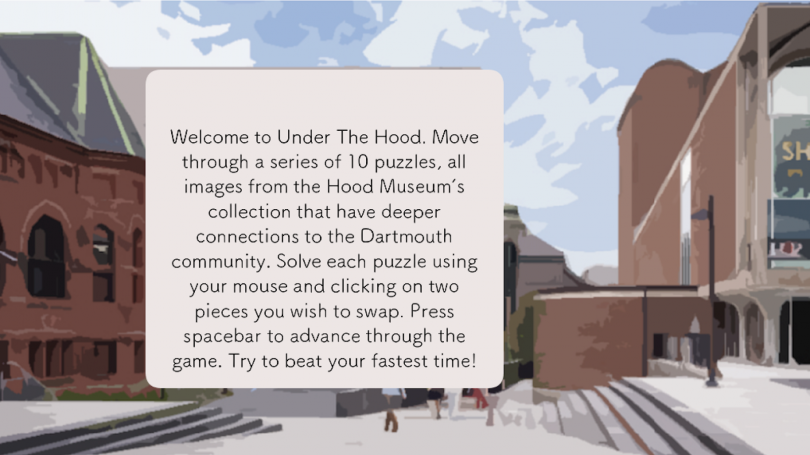Halle Dantas '21, an art history and public policy major, based her Computer Science 2 final project on the Hood Museum's collection. Read her interview to learn more.
Tell us about your project.
For my final project, I created a game based on Dartmouth's Hood Museum of Art. As an art history major, I've always been interested in visual culture and ever since the Hood opened, I've enjoyed visiting the museum. Today, museums are turning into "backdrops for Instagram," spaces where patrons come to take pictures of the art and themselves rather than experiencing the work. I wanted to create a game that forces players to slow down and consider the work in terms of its formal qualities and written history. Although this is a game, it is really an exercise in discovering the Hood's collection and training your visual eye. The game consists of 10 puzzles that the user can solve by clicking two pieces to swap them into the correct position. A complete photograph of the work appears on the screen before the puzzle so you know what you are solving. Each artwork in the game has a deeper connection to Dartmouth. For example, there is a portrait of Samson Occom, a key figure in the founding of the college. Another work is The Return by Paul Sample, although the connection to Dartmouth here is not as explicit, the work was donated by the Hood family, and all Dartmouth students can relate to trekking across a snowy landscape! Each work has a background associated with it that connects to the piece. For example, the Samson Occom background is the Mohegan motif as he was a member of this tribe and people suspect that the motif was meant to be painted on the unfinished portion of his neck. After the player solves the puzzle, they can advance to the next screen which has a write-up on the work which I compiled using many of the Hood's resources.
What inspired you to use the Hood's collection?
One of the reasons I chose the Hood's collection in creating this project was because I could see each piece in person before including it in my game. Experiencing a piece of art in real life is very different than seeing a piece virtually. One of the best examples of this is The Dartmouth Oxbow that I included in the game. The nuances of the piece were only apparent to me when I visited the Hood so I thought the ability for me, and those who tested my game, to see the pieces in real life was important. Additionally, Dartmouth's collection is very special in that many of the pieces can be traced to the early days of the college, and in many cases even prior. I liked the idea that each of the works I chose had a deeper connection to the Dartmouth community. I thought this would make the game more interesting for those who tested and played it as most of the players are members of our community.
What was your favorite part of this project? Did anything surprise you?
One of my favorite parts of the project is watching other people play the games. It is very cool to see others interact with your work. I've noticed that different people interact with it quite differently. When I showed the project to Amelia Kahl, the Andrew W. Mellon Associate Curator of Academic Programming at the Hood, she knew a lot about the pieces both in terms of their aesthetics and history, so she moved through the game quite quickly. When I showed it to friends who had never been to the Hood, however, they interacted with the game differently, taking a bit longer to solve each puzzle. I also think the last screen is very fun! It is a photograph of a gallery wall and webcam image is broadcasted onto the wall. You can take a picture of yourself using the "c" button. I felt like this was a fun feature that also speaks to the idea of museums as a backdrop for Instagram. Everyone seems to enjoy it though and it was fun to design and code!
Did your participation in Museum Club help with or influence this project? How so?
During the fall 2019 term, I joined the Museum Club, which helps promote the Hood to the student body. Through the club, I met peers who had creative ideas on how to promote the Hood and make it an engaging space for students. For example, Hadley Detrick '22 helped create the Hood's Playlist Project, which serves as a creative way to experience the Hood's collection by pairing artwork with music. When it came time to create a project for my computer science class, I wanted to find a new way to engage students with the museum as we had done during Museum Club with projects like Hadley's and our termly Hood After 5 event.
View excerpts of Dantas' project via the slideshow!





